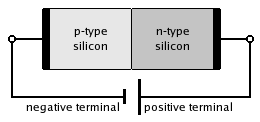P-n junction
|
|
A p-n junction is formed by combining N-type and P-type semiconductors together in very close contact. The term junction refers to the region where the two types of semiconductor meet. It can be thought of as the border region between the P-type and N-type blocks as shown in the following diagram:
PN_Junction_Open_Circuited.png
The p-n junction possesses some interesting properties which have useful applications in modern electronics. P-doped semiconductor is relatively conductive. The same is true of N-doped semiconductor, but the junction between them is a nonconductor. This nonconducting layer, called the depletion zone, occurs because the electrical charge carriers in doped n-type and p-type silicon (electrons and holes, respectively) attract and eliminate each other in a process called recombination. By manipulating this nonconductive layer, p-n junctions are commonly used as diodes: electrical switches that allow a flow of electricity in one direction but not in the other (opposite) direction. This property is explained in terms of the forward-bias and reverse-bias effects, where the term bias refers to an application of electric voltage to the p-n junction.
| Contents |
Forward-bias
Forward-bias occurs when the P-type block is connected to the positive terminal of a battery and the N-type block is connected to the negative terminal, as shown below.
PN_Junction_in_Forward_Bias.png
With this set-up, the 'holes' in the P-type region and the electrons in the N-type region are pushed towards the junction. This reduces the width of the depletion zone. The positive charge applied to the P-type block repels the holes, while the negative charge applied to the N-type block repels the electrons. As electrons and holes are pushed towards the junction, the distance between them decreases. This lowers the barrier in potential. With increasing bias voltage, eventually the nonconducting depletion zone becomes so thin that the charge carriers can tunnel across the barrier, and the electrical resistance falls to a low value. The electrons which pass the junction barrier enter the P-type region (moving leftwards from one hole to the next, with reference to the above diagram).
This makes an electric current possible. An electron starts flowing around from the negative terminal to the positive terminal of the battery. It starts at the negative terminal, moving towards the N-type block. Having reached the N-type region it enters the block and makes its way towards the p-n junction. The junction barrier can no longer keep the electron in the N-type region due to the forward-bias effect (in other words, the thin depletion zone produces very little electrical resistance against the flow of electrons). The electron will therefore cross the junction and move ahead into the P-type block. Once inside the P-type region, the electron will jump from one available hole to the next, making its way to the positive terminal of the power supply. This process will be repeated over and over again, producing a complete circuit path through the junction.
Reverse-bias
Connecting the P-type region to the negative terminal of the battery and the N-type region to the positive terminal, produces the reverse-bias effect. The connections are illustrated in the following diagram:
Because the P-type region is now connected to the negative terminal of the power supply, the 'holes' in the P-type region are pulled away from the junction, causing the width of the nonconducting Depletion Zone to increase. Similarly, because the N-type region is connected to the positive terminal, the electrons will also be pulled away from the junction.
This effectively increases the potential barrier and greatly increases the electrical resistance against the flow of charge carriers. For this reason there will be no (or minimal) electric current across the junction.
At the middle of the junction of the p-n material, a depletion region is created to stand-off the reverse voltage. The width of the depletion region grows larger with higher voltage. The electric field grows as the reverse voltage increases. When the electric field increases beyond a critical level, the junction breaks down and current begins to flow by avalanche breakdown.
Summary
The forward-bias and reverse-bias properties of the p-n junction imply that it can be used as a diode. A p-n junction diode allows an electric charges to flow in one direction, but not in the opposite direction. When the p-n junction is forward-biased, electric charge flows freely due to reduced resistance of the p-n junction. When the p-n junction is reverse-biased, however, the junction barrier (and therefore resistance) becomes greater and charge flow is minimal.
Non-rectifying Junctions
In the above diagrams, contact between the metal wires and the semiconductor material also creates metal-semiconductor junctions called Schottky diodes. In a simplified ideal situation a semiconductor diode would never function, since it would be composed of several diodes connected back-to-front in series. But in practice, surface impurities within the part of the semiconductor which touches the metal terminals will greatly reduce the width of those depletion layers to such an extent that the metal-semiconductor junctions do not act as diodes. These "nonrectifying junctions" behave as ohmic contacts regardless of applied voltage polarity.

